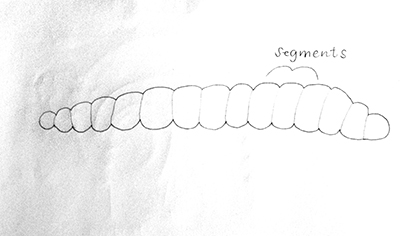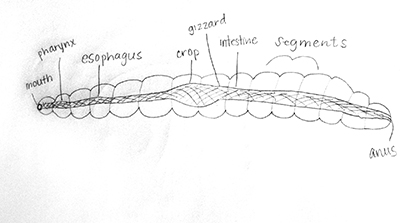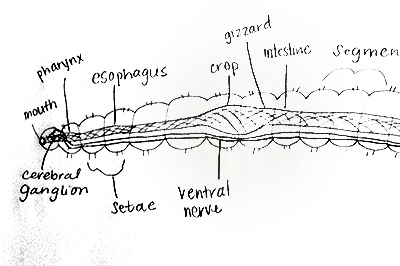All Annelids have segmented bodies and are bilaterally symmetrical. Some have parapodia and setae. What are parapodia and setae? Think of the answer, then click Show Me to see if you are correct.

Parapodia are paddle-like appendages and setae are thin bristles found on many annelids.
Annelids are the most complex of all worms in that they have segments, which indicates a high level of organization. They have organ systems including circulatory, respiratory, digestive, excretory, and reproductive systems.
Click through the activity below to learn how to draw an earthworm, a common Annelid.
Outline and Segments
First, draw the outline of the Annelid. Be sure to draw segments (ring-like structures) over the length of the entire body. Label the segments. Digestive Tract
Second, draw the digestive tract, starting with the mouth on one end, which will be designated the anterior end. Include the pharynx, esophagus, crop, gizzard, intestine, and anus, in that order. The anus should be on the opposite end of the body. What is the name of the end opposite the anterior side? Think of the answer, then click Show Me to see if you are correct.
The posterior end is opposite the anterior end. Label the mouth, pharynx, esophagus, crop, gizzard, intestine, and anus. Nervous System
Third, draw a glob on top of the esophagus to represent the cerebral ganglion. The cerebral ganglion is a simple or primitive version of what organ? Think of the answer, then click Show Me to see if you are correct.
The cerebral ganglion is a simple brain. Next, draw a ventral nerve along the ventral (belly) side of the entire body. Then, draw thin hairs on all the segments to represent the setae. Label the cerebral ganglion, ventral nerve, and setae. Hearts
Finally, draw five hearts on the anterior end of the body. Label the hearts. |




